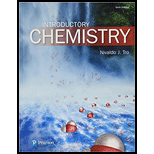
Concept explainers
Which statement is not part of Dalton’s theory? a. Each element is composed of indestructible particles called atoms. b. All atoms of a given element have the same mass and other properties. c. Atoms are themselves composed of protons, neutrons, and electrons. d. Atoms combine in simple whole-number ratios to from compounds.
Interpretation: Amongst the given statements, the statement which is not a part of Dalton’s atomic theory is to be determined.
Concept Introduction: John Dalton was a British school teacher who studied about atoms through various experiments and came up with some postulates related to the atom in 1808.
Answer to Problem 1SAQ
Correct Answer: The statement that theatoms are made up of protons, neutrons, and electrons is not a part of Dalton’s atomic theory.
Therefore, option c is correct.
Explanation of Solution
Reason for correct option:
Dalton stated that “All matter consists of indivisible particles called atoms.” This rules out the possibility of anatom being composed of any other smaller particles like protons, neutrons, and electrons.
Hence, option c is correct.
Reasons for incorrect options:
Option (a) contains a statement that states that each element is made up of indestructible particles called atoms. This is apostulate of Dalton’s atomic theory. So, it is a wrong answer.
Option (b) contains a statement that states that all atoms of a given element have identical masses as well as other properties. This is apostulate of Dalton’s atomic theory. So, it is a wrong answer.
Option (d) contains a statement that states that the atoms combine in the form of whole-number ratios for the formation of compounds. This is apostulate of Dalton’s atomic theory. So, it is a wrong answer.
Hence, options (a), (b), and (d) are incorrect.
Want to see more full solutions like this?
Chapter 4 Solutions
INTRODUCTORY CHEMISTRY-W/SEL.SOLN.MAN.
Additional Science Textbook Solutions
Chemistry: A Molecular Approach (4th Edition)
Organic Chemistry (9th Edition)
Chemistry For Changing Times (14th Edition)
Chemistry: An Introduction to General, Organic, and Biological Chemistry (13th Edition)
Chemistry: Structure and Properties
Chemistry & Chemical Reactivity
- A fundamental idea of Daltons atomic theory is that atoms of an element can be neither created nor destroyed. We now know that this is not always true. Specifically, it is not true for uranium and lead atoms as they appear in nature. Are the numbers of these atoms increasing or decreasing? Explain.arrow_forwardCalculating Atomic Mass Magnesium has three naturally occurring isotopes with masses 23.99,24.99,and25.98amu and natural abundances 78.99,10.00,and11.01%. Calculate the atomic mass of magnesium.arrow_forwardState the main points of Dalton’s atomic theory usingyour own words. Which parts of Dalton’s theory werelater found to be erronous? Explain why.arrow_forward
- Average atomic masses listed by JUPAC are based on a study of experimental results. Bromine has two isotopes 79Br and 81Br, whose masses (78.9 183 and 80.9 163 amu) and abundances (50.69% and 49.3 1%) were determined in earlier experiments. Calculate the average atomic mass of bromine based on these experiments.arrow_forwardThe CRC Handbook, a large reference book of chemical and physical data, lists two isotopes of rubidium (Z=37). The atomic mass of 72.15 of rubidium atoms is 84.9118u. Through a typographical oversight, the atomic mass of the second isotope is not printed. Calculate that atomic mass.arrow_forwardDo the proton and the neutron have exactly the same mass? How do the masses of the proton and the neutron compare to the mass of the electron? Which particles make the greatest contribution W the mass of an atom? Which particles make the greatest contribution to the chemical properties of an atom?arrow_forward
- Dalton’s original atomic theory proposed that all atoms of a given element areidentical. Did this turn out to be true after further experimentation was carried out? Explain.arrow_forwardThe existence of isotopes violates one of the original ideas of Dalton’s atomic theory. Which one?arrow_forwardThe atomic weight of aluminum is 26.98u and the atomic weight of nickel is 58.69u. All aluminum atoms have a mass of 26.98u, but not a single atom of nickel has a mass of 58.69u. Explain.arrow_forward
- Your friend tells you about an article that he read in a tabloid that reported the discovery of a new form of carbon containing eight protons in the nucleus of its atoms. He claims that scientists are eager to explore the properties of this new form of carbon. What is wrong with the tabloid's claim? a. Nothing. The claim is believable. b. The claim must be false because an atom with eight protons would be oxygen, which is already known. c. The claim must be false because all forms of carbon are already known.arrow_forwardThe Rutherford experiment was performed and its conclusions reached before protons and neutrons were discovered. When they were found, why was it believed that they were in the nucleus of the atom?arrow_forward
 World of Chemistry, 3rd editionChemistryISBN:9781133109655Author:Steven S. Zumdahl, Susan L. Zumdahl, Donald J. DeCostePublisher:Brooks / Cole / Cengage Learning
World of Chemistry, 3rd editionChemistryISBN:9781133109655Author:Steven S. Zumdahl, Susan L. Zumdahl, Donald J. DeCostePublisher:Brooks / Cole / Cengage Learning Introductory Chemistry: A FoundationChemistryISBN:9781337399425Author:Steven S. Zumdahl, Donald J. DeCostePublisher:Cengage Learning
Introductory Chemistry: A FoundationChemistryISBN:9781337399425Author:Steven S. Zumdahl, Donald J. DeCostePublisher:Cengage Learning Introductory Chemistry: An Active Learning Approa...ChemistryISBN:9781305079250Author:Mark S. Cracolice, Ed PetersPublisher:Cengage Learning
Introductory Chemistry: An Active Learning Approa...ChemistryISBN:9781305079250Author:Mark S. Cracolice, Ed PetersPublisher:Cengage Learning Living By Chemistry: First Edition TextbookChemistryISBN:9781559539418Author:Angelica StacyPublisher:MAC HIGHER
Living By Chemistry: First Edition TextbookChemistryISBN:9781559539418Author:Angelica StacyPublisher:MAC HIGHER Chemistry: Matter and ChangeChemistryISBN:9780078746376Author:Dinah Zike, Laurel Dingrando, Nicholas Hainen, Cheryl WistromPublisher:Glencoe/McGraw-Hill School Pub Co
Chemistry: Matter and ChangeChemistryISBN:9780078746376Author:Dinah Zike, Laurel Dingrando, Nicholas Hainen, Cheryl WistromPublisher:Glencoe/McGraw-Hill School Pub Co





